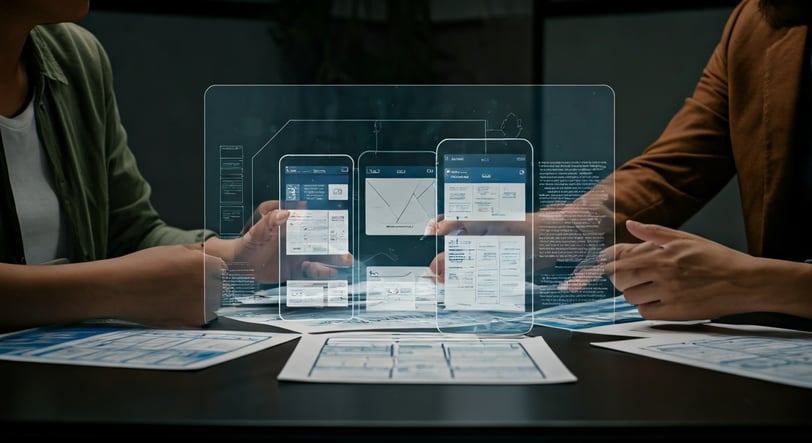
User-Centered Design in Mobile App Development
The success of your mobile app depends on how well it meets user expectations. User-centered design puts people at the center of the development process. It helps shape the app into a tool that is easy to use and brings value to their lives. This approach, unlike older ways that focus only on technical work, uses user feedback and usability testing to make sure the app fits what people want and helps with their pain points. By using design principles and an iterative process, user-centered design turns mobile app development into a plan to give users a great experience.
MOBILE APP DEVELOPMENT
Key Highlights
User-centered design prioritizes user needs, behaviors, and preferences, ensuring mobile apps are intuitive and enjoyable to use.
Conducting thorough user research identifies pain points, motivations, and user insights, establishing a solid foundation for development.
Iterative processes like usability testing and prototyping refine the app design, leading to better user satisfaction.
Emphasising accessibility through features like screen readers and voice commands broadens the app's user base inclusively.
Combining user feedback with business goals ensures balanced design decisions for long-term business success.
Personalization and customization enhance the overall user experience, promoting retention and engagement.
Introduction
The success of your mobile app depends on how well it meets user expectations. User-centered design puts people at the center of the development process. It helps shape the app into a tool that is easy to use and brings value to their lives. This approach, unlike older ways that focus only on technical work, uses user feedback and usability testing to make sure the app fits what people want and helps with their pain points. By using design principles and an iterative process, user-centered design turns mobile app development into a plan to give users a great experience.
Key Elements of User-Centered Design in Mobile App Development
Making mobile apps that meet user needs starts by focusing on user-centered design. This means beginning with in-depth user research and collecting user feedback. Using an iterative approach, developers build apps that fit what the target audience wants.
When you add empathy and inclusivity into the design process, the app gets easier to use and more accessible. With carefully planned steps, mobile apps can become simple and easy for people. These steps help the app meet needs, go beyond what people expect, and give everyone a smooth experience. All of this is important for good app development.
1. Conducting Comprehensive User Research
Effective mobile app design starts with strong user research. The goal is to find out about user behavior and pain points. Developers use surveys and interviews. They also use tools to learn more about the people who use their app and what they want. These ways help developers see how users act with other mobile applications. This knowledge makes it easier to find the right answers during app development.
When developers understand what the target audience wants and what problems they have, a mobile app can meet real needs. This work gives a clear path forward for each step of creating the app, so the app stays important to users.
User insights help developers make choices through all parts of the app development process. This makes it easier to get things right without guessing, which helps save time and resources. Good research lets developers build apps people really enjoy using and helps their mobile applications stand out.
2. Defining Clear User Personas
User personas show who the real users are. These personas come from data that teams collect during user research. The fictional characters in a user persona stand for different people in the target audience. Each one has their own specific needs, goals, and ways of acting.
When teams understand these user personas, they can pick features and come up with design decisions that fit what people want. For example, if Persona A wants simple and intuitive navigation, or if Persona B needs better access, the team knows what the app has to give. This helps the development process include everyone.
A strong user persona is very helpful in the design process. It lets developers check if new features match what real users want. By looking at the persona's details, teams make sure their work meets user expectations every step of the way. This key step turns user satisfaction into a main goal in the app development process, so the finished product feels right for the people who use it.
3. Designing Intuitive User Interfaces
An excellent user experience starts with an interface that is easy to use and simple to move around in. With the right design principles, like smooth steps and clear layouts, people can do things without hassle. This makes them want to use the app more.
When you create intuitive navigation, you put focus on being clear and making sure everything works well. This cuts down on problems and helps users move through the app easily. By sticking to UX design best practices, developers work to keep things the same at every step, which helps people have an enjoyable experience.
In the end, a clear and easy-to-use interface helps raise user satisfaction. This can make people come back again and again. With a thoughtful design, first-time users can quickly become people who really like how the app works.
4. Prioritizing Accessibility and Inclusivity
Creating apps with inclusive design ideas helps everyone use them in the same way. By adding things like screen readers, voice commands, different text sizes, and easy menus, these apps work well for many people.
Screen readers let people who are blind or have trouble seeing use the app with ease.
Voice commands make it simple for people with trouble moving to use the app.
Being able to change text size helps people who have visual problems.
Choosing colors that stand out from each other helps people who are color blind see better.
Making apps easy to use for all is not only the right thing to do. It also brings in more people, helping to grow the user base and build trust. Apps with good inclusive design make the whole community stronger and more connected.
5. Implementing Iterative Prototyping and Testing
Iterative prototyping is about making early versions of the app. These first drafts focus on how easy it is to use and how it looks. During usability tests, developers practice A/B testing. This helps the team check design decisions and collect clear feedback from people who use the app. They use what they find out to make the app better.
The real strength of the iterative approach comes from looking at prototypes over and over again. They keep making changes based on what users say they like. This cycle helps to cut down problems with usability. It also helps the app work the way people want and meets user expectations.
By using these kinds of tests, designers can make the app easier to move around, more useful, and better-looking. In the end, the product fits user preferences and many people enjoy using it.
6. Integrating Continuous Feedback Loops
An app needs to keep people interested to do well. By getting user feedback all the time, the app can change to fit user needs. Developers add ways to collect feedback right in the app. This helps make the app better.
When you use feedback loops, you can quickly find what needs to change. You get to see problems with moving around the app or spot features people do not notice. This helps the development process.
Making these small changes again and again makes users happier. It shows that the app cares about the user community. This helps keep people coming back and builds long-term user satisfaction.
7. Balancing User Needs with Business Goals
Finding the right mix between user needs and business goals is important for app development that lasts. Users want fresh and simple features. But, companies need to watch development costs to stay profitable.
Good talk between all people involved helps make choices that put users first and push business success. It is smart to focus on changes that help the most users while not going over the budget. This way, both sides are taken care of.
Apps built this way make their users happy and help the business grow. This keeps the business strong in a market where many others try to win.
8. Focusing on Personalization and Customization
Modern apps focus on personalization and customization, making the user journey fit each person’s likes. Many developers now give users new ways to make the app feel just right for them. This approach helps people get a unique experience they want and enjoy.
Apps often let you change layouts or offer tips based on user behavior. These small touches can make people feel good about using the app. Mixing customization with data can help more users get involved and spend time in the app.
When someone thinks the app gets what they need, they are likely to stick with it. Personalizing the app often makes the user experience better. It can even turn an app into something people use every day in their lives.
Best Practices for Implementing User-Centered Design in Mobile Apps
Using user journey mapping is important. It helps to see how users interact with the app. This lets us spot pain points that need to be fixed. When teams work together, they bring different ideas to the design philosophy. This helps to come up with better and new ways to solve problems.
If you use simple steps like making and testing early app models again and again, you can work faster. You still keep the quality high. Making apps that everyone can use means the app is open to all. This connects more people and makes them happy using the app. The right user journey makes a big difference.
Collaborating Across Multidisciplinary Teams
Successful user-centered approaches need team members from different backgrounds to work together. Designers, developers, and marketers all have their own skills that help make the project better.
When these people work as a team, the group learns more about users. This helps the design process because it mixes new ideas and technical knowledge. If everyone stays involved in the development process, the team can come together and new ideas can grow.
Teams that do many kinds of work can make apps people really use in life. They use user insights and mix different ideas and thinking to get the best results.
Maintaining Consistency Throughout the App Experience
Keeping things consistent helps the app give a better overall user experience. The look and feel of the app should follow known design principles. The layout, how you move around, and the features should all match.
When the app works smoothly like this, people trust it more. This can lead to brand loyalty, because users feel the app is always the same and works well. Testing the app often helps make sure the final product looks good and works right every time.
By making consistency the focus, developers can build apps that help people know and trust them. This also helps users feel comfortable and come back again, helping the app give a better user experience.
Conclusion
To sum up, focusing on user needs in the design process is key to making mobile applications that people like to use. When you design your mobile app with users in mind, you give them a better experience. This leads to more people being happy and using your app for a long time. Look at every part of app development, from user research to getting feedback all the time. Each step helps your mobile app become better.
You should always try to balance the user needs with what the business wants. This helps your mobile app make people happy and meet your own goals at the same time. Follow these best practices during mobile app development, and your app will do well in a busy market. If you want to make your app development stronger, contact us now!
Frequently Asked Questions
What are the biggest challenges in adopting user-centered design for mobile apps?
There are some common problems in the development process. These include changing the culture in the organisation so people accept user-centered design. Teams also have to manage tight deadlines and not always have enough resources. It takes ongoing work and planning to balance good user research with usability testing. People need to take action at each step of the development process to make things work.
How does user-centered design improve mobile app retention rates?
Keeping the focus on user satisfaction with features that are easy to use, fun experiences, and ways to keep people involved helps users stay with the app. Apps that meet or even go beyond what users expect help build loyalty. This, over time, leads to better user retention.
What tools help with user research in mobile app development?
Some good tools for user research are surveys, analytics, heatmaps, and usability testing. These tools help you get user feedback. They also make the design process smoother when you create mobile applications. With them, you can know what people want and make better apps.
How can small teams implement user-centered design effectively?
Small teams can use an iterative design process and put user feedback first. By working with custom mobile app development services and following best practices, they get a mobile app that fits user needs well. This way, teams make targeted and scalable solutions without putting too much strain on their resources. You can meet what people want and make things work better by using these app development services.



